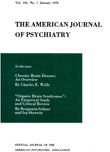THE STUDY AND TREATMENT OF ALCOHOLISM IN THE 5TH S. C. REHABILITATION CENTER
Abstract
1. A new alcoholic terminology was developed to bridge the 'gap' between the social drinker and the chronic alcoholic.
2. About a third of our population shows essentially normal personalities, and psychoses and psychoneuroses are quite rare.
3. Although many people express the view that alcoholism originates in the Army; a careful survey showed that this was an exceedingly rare occurrence.
4. Those who were diagnosed chronic alcoholics (in the Army) generally showed a previous history of drinking for 5 to 15 years.
5. Survey of case records indicates that an overwhelming majority of alcoholics have an underlying defect of schizoid or neurotic personality.
6. The thorough program promulgated at this Center has been effective in treating and reeducating alcoholics, and is particularly successful in those labeled 'alcoholism.'
7. A most recent review of more than 550 men restored to duty from the 5th Service Command Rehabilitation Center in the last 2 years (alcoholics and others) revealed that less than 5% had to be returned to a disciplinary barracks.
8. Education of the public, and reeducation of chronic alcoholics on a scale of world wide publicity is advocated as an important method of prophylaxis.
Access content
To read the fulltext, please use one of the options below to sign in or purchase access.- Personal login
- Institutional Login
- Sign in via OpenAthens
- Register for access
-
Please login/register if you wish to pair your device and check access availability.
Not a subscriber?
PsychiatryOnline subscription options offer access to the DSM-5 library, books, journals, CME, and patient resources. This all-in-one virtual library provides psychiatrists and mental health professionals with key resources for diagnosis, treatment, research, and professional development.
Need more help? PsychiatryOnline Customer Service may be reached by emailing [email protected] or by calling 800-368-5777 (in the U.S.) or 703-907-7322 (outside the U.S.).



